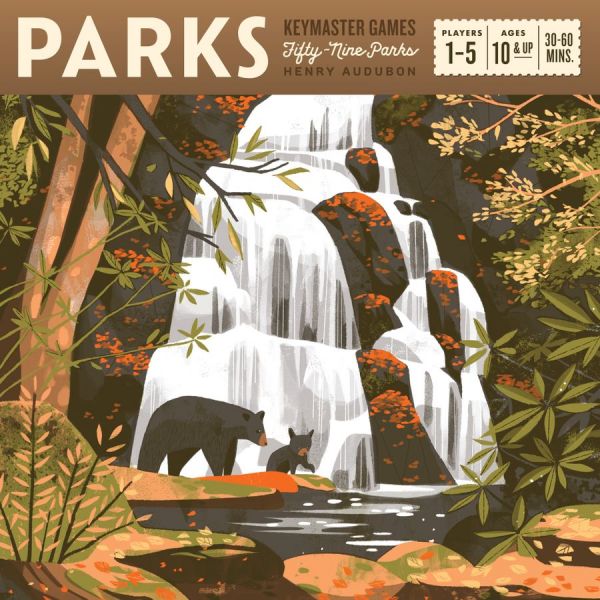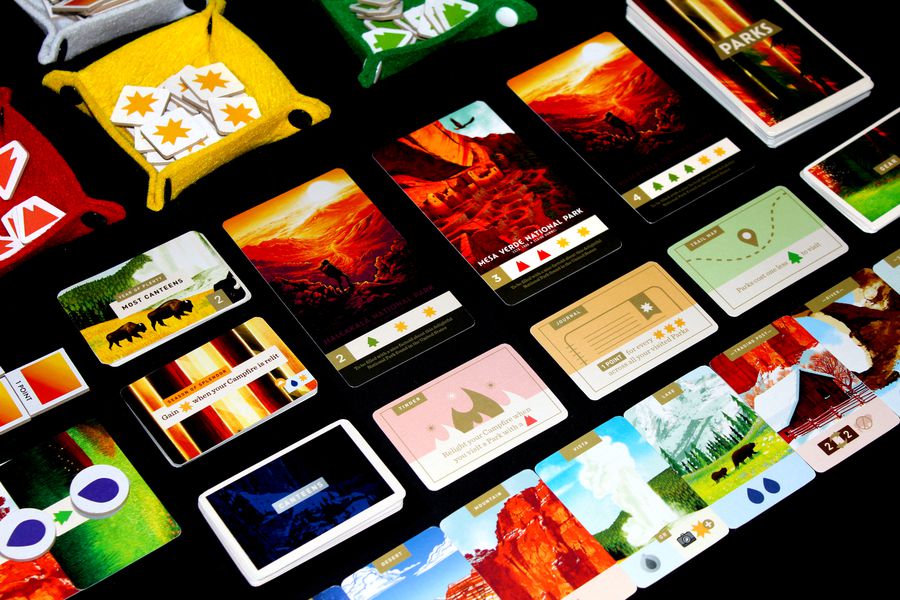Hike Along the Trail and Visit National Treasures in Parks

The Keymaster Games team partners with The Fifty-Nine Parks Print Series to create a game that celebrates the beauty of U.S. National Parks.
Gameplay
Parks is a 1 to 5 player game that tasks players with sending their two hikers along an ever-changing trail to gather resources to fulfill the requirements of Park, Gear, and Trail cards in a race to the highest victory point total.
Play begins with three random Park and Gear cards being laid out, as well as face-down Canteen and Seasons card piles. Players will then shuffle up the core five Trail tiles along with one of the five special trail titles and then place them out blindly between the trail’s start and end tiles. Players will choose a Year card, giving them specific end-game goals to meet with varying point totals. Finally, the top card from the Seasons card pile will be turned face up, detailing the resources to place out on the trail tiles and in which pattern, as well as any additional benefit for the round (examples include ignoring a specific resource to fulfill the requirements of a Park or Gear card). Specific tiles will also allow players to take certain actions, such as reserving a Park card, buying a Gear card, or acquiring or filling a Canteen card.
Players can move along the trail as they wish with their two hikers, with one caveat: hikers of any color cannot share a space. There is one exception, with the use of the campfire tile each player receives. By extinguishing the campfire (turning over the tile), a player may choose to occupy the same trail tile as another hiker. Beyond what the trail tiles may offer in resources and buying opportunities, the last trail tile allows players to fulfill the requirements of a Park or Gear card to claim it, to reserve a Park card, or to gain the first player marker.
Players may also collect photograph tiles along the trail during their journeys. Photographs can be used for various purposes, such as to trade for wildcard resources (on the appropriate trail tiles) or to meet requirements on Year cards. If a player has possession of the camera token, they gain a discount for any photograph actions.
A round ends when one last hiker remains on the trail. At this point, that hiker advances to the final trail tile and performs the action they want. Trail tiles are collected, a new one is randomly selected and shuffled, and the trail tiles are laid out. A new season occurs with resources being placed in the appropriate pattern, and the new round begins. Victory points are earned by collecting Parks cards, meeting the requirements of a Year card goal, and possessing the first player and camera tokens (each worth one victory point). The game lasts four rounds, with the player gaining the most victory points winning the game.

Photo by Erik Yurko, licensed under CC BY-NC-SA 3.0.
Review
Parks is a well-crafted, exquisitely beautiful game. The stylized art, produced by a multitude of artists within and outside of board gaming, is breathtaking. Despite its compact packaging, this presentation brings the theme of Parks to life. Gathering Canteen cards to get added benefits, buying Gear cards for new abilities, and chasing resources and photographs to collect Park cards and meet Year card goals capture a bit of a hiker’s paradise. It feels like a newly minted hiker filling out their park guides, selecting what they’ll need on the trail, and taking it all in as they work to cross off another U.S. National park off their bucket list.
The game’s central mechanic also makes immersion easier. Movement along the trail is easy to understand, though it can become complex as the trail fills up with other hikers and spots become coveted. This makes resources more precious and, therefore, some rounds may become a race to specific locations to hoard whatever is possible so that in a future round Park or Gear cards can be gained as soon as possible to prevent someone else from acquiring them first. In this regard, it’s an area where the veil of the theme can be broken. In smaller player counts (2-3 players), there are more resource opportunities. Therefore, the pace of navigating the trail is a bit more tranquil even in the heat of competition.
Yet the Trail tiles are not all peaceful. A particular Trail tile allows players the option of taking a Park action (either reserving or fulfilling the requirements of a Park card) or to buy a Gear card. However, this can cause headaches in lower player counts if, by the random draw, the tile does not make it into the game in early rounds. With a limit of 12 resources in a player’s reserve, it becomes hard to spend them to obtain Gear and Park cards in a timely manner. And depending on where the tile also appears on the trail, it may become useless. However, it’s also a great tile because if a player navigates the thin line of resource management just right, they may have a turn where they sweep up all the Park and Gear cards they want in one fell swoop.
Parks does have a drawback that is exacerbated in any player count: end-game goal scoring. Many Year cards will provide a lower goal to meet that earns players two victory points at the end of the game for meeting the requirements, and a higher goal is worth three points. Meeting these goals can be tedious and difficult in high player counts, but doing so may mean the difference between winning and losing the game. In lower player counts, it’s easy to meet the requirements but the low point totals make them feel fruitless.
Scoring is the weak point of Parks. While the mechanics are fun, the theme immersive, and the art and design elegant, scoring is engineered to always be low-scoring and create tight games. This is great for a casual game but may not provide new board gamers with a platform to be prepared for similar games where these mechanics can yield a lot of points and massively swing a game. It’s nice that Parks has mitigated a lot of that swing, but it can also be slightly unsatisfying when one player makes all the right moves and seemingly runs away with a game only to find that they won by no more than 3-4 points in low player counts.
That said, Parks is a bevy of wonderful accomplishments that will help move the hobby forward. Casual gamers are going to love its simplicity in picking it up and depth in how hikers move along the trail and maximizing those movements with power-ups and end-game goals in mind. The tightness in scores will also be encouraging, especially for young gamers, who want to feel as if they are worthy competitors for their older, more seasoned opponents.
Parks is quintessential Keymaster. It is another pristine example of the publisher’s ethos of making many Euro-style mechanics accessible and approachable for casual gamers, and it does so by being as beholden to its theming as possible. And its solo variant, introducing Event cards for greater replayability, is a treat of its own.
Pros: Exquisite design and components, easy to learn with a depth of strategy, excellent and immersive theming, solid solo variant
Cons: Luck is a factor in the composition of Trail tiles, end-game goals are not always rewarding enough during scoring




